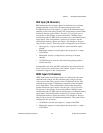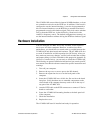
Chapter 2 Configuration and Installation
©
National Instruments Corporation 2-13 AT-MIO-16X User Manual
The AT-MIO-16X can use either its internal 10-MHz timebase, or it can
use a timebase received over the RTSI bus. In addition, if the board is
configured to use the internal timebase, it can also be programmed to
drive its internal timebase over the RTSI bus to another board that is
programmed to receive this timebase signal. This clock source, whether
local or from the RTSI bus, is then divided by 10 and used as the
Am9513A frequency source. The default configuration at startup is to
use the internal timebase without driving the RTSI bus timebase signal.
Hardware Installation
You can install the AT-MIO-16X in any available 16-bit expansion
slot in your AT Series computer. However, to achieve best noise
performance, you should leave as much room as possible between the
AT-MIO-16X and other boards and hardware. The AT-MIO-16X does
not work if installed in an 8-bit expansion slot (PC Series). After you
have made any necessary changes, verified, and recorded the switches
and jumper settings (a form is included for this purpose in Appendix D,
Customer Communication), you are ready to install the AT-MIO-16X.
The following are general installation instructions, but consult your PC
user manual or technical reference manual for specific instructions and
warnings.
1. Turn off your computer.
2. Remove the top cover or access port to the I/O channel.
3. Remove the expansion slot cover on the back panel of the
computer.
4. Insert the AT-MIO-16X into a 16-bit slot. Do not force the board
into place. Verify that there are no extended components on the
circuit board of the computer that may touch or be in the way of
any part of the AT-MIO-16X.
5. Attach a RTSI cable to the RTSI connectors to connect AT Series
boards to each other.
6. Screw the AT-MIO-16X mounting bracket to the back panel rail
of the computer.
7. Check the installation.
8. Replace the cover.
The AT-MIO-16X board is installed and ready for operation.


















